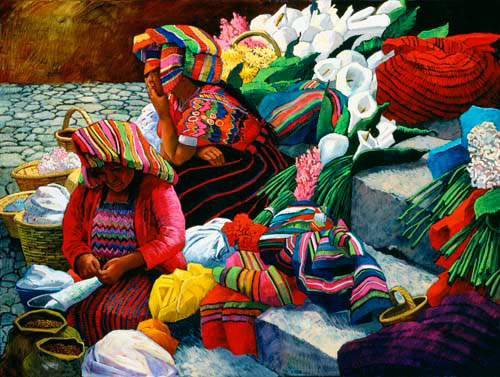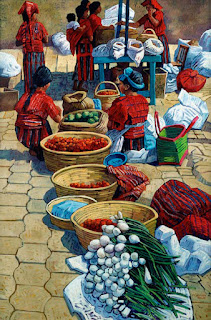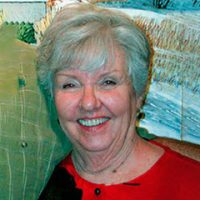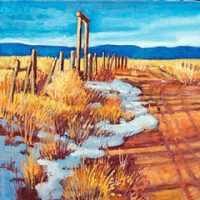
The pace of this trip was exhausting. Prior to heading for the Friday Market in Solola and Lake Atitlan we had spent a night at Posada de Belen. Damp dark sleeping room – the courtyard where Sister Ortiz had been kidnapped – my first hint that this was far more than a photo trip for paintings. This was my Awakening to a world reality darker than anything I ever imagined…yet determined to hang onto that hazy state of blissful ignorance…..
THE CHINESE MONEY CHANGER: Anticipating some purchases at the Friday market in Solola, I changed my dollars into quetzals at the bank. Great excitement as we boarded the bus…included in this leg of our adventure was a boat trip across Lake Atitlan to the small village of Santiago Atitlan. Upon arriving at our new destination, the bus emptied out to make a stop at the Chinese money changer. I could see him from the open front door. A small man sitting at a large desk under a bright overhead lamp hunched next to a pile of money. My impression was that of an old Humphrey Bogart movie with Sydney Greenstreet. The bus driver had parked across the street close to an adobe building. Sitting at the right window seat next to the wall outside, I prepared for a little much needed quiet time. I had the strange feeling of being watched. When I looked up two men with machine guns pointed at the door across the street were staring at me from the roof of the building above. The barrels of the guns were long and menacing as were the men’s stares. Holy St. Christopher! This trip just got very serious! Without a glance at the guns pointed directly at them, our group clutched their wallets and purses, reboarded the bus and we were on our way….this was no movie!
FRIDAY MARKET – SOLOLA: Bedazzled by the colors – the “traje” – huipils, loom-woven sashes and headbands – individual works of art. And, oh, the “gente” -the Maya are beautiful people! Baskets and baskets of tomatoes, onions, peppers – a low hum of conversation as people strolled among the vendoras’ baskets and made their purchases.

SANTIAGO ATITLAN – Time to find the boat launch for the crossing of Lake Atitlan (the place where the rainbow gets its colors). An incredibly beautiful volcanic lake, set 1,500 meters above sea level and reaching a depth of 341 meters – making it the deepest lake in Central America. It’s a true marvel that was formed 84,000 years ago due to a volcanic eruption. According to the boatman, timing was all important to cross the lake, make a brief visit the village across the lake and make the return trip before the winds and the waves whipped up later that afternoon.
As we began our walk through the village, young girls were seated at their hand looms weaving colorful belts. Across the square there was a long building. Many women sat under the portal selling whatever they could – housewares, weavings – in order to support their families. It was call “Mercado de las Viudas” (the Widow’s Market).
“ON 2 DECEMBER 1990, the Guatemalan Army opened automatic weapons fire on an unarmed crowd of between 2,000 and 4,000 Tzutujil Mayas from the town of Santiago Atitlan in highland Guatemala, about 100 miles west of the capital. Fourteen people, ranging in age from 10 to 53, were killed; another 21 were wounded.” The return trip across the lake was a very sad and choppy ride. Unforgettable.
TIKAL AND THE CLOUD FOREST — Our group of sweaty Americans finally awakened to the undercurrent of danger as the warnings of the trip to Peten became quite serious – some abductions and robberies along the highway. Concerned about their safety several surrounded our very patient bus driver asking him questions he would not or could not answer. It was obvious their questions caused him fear. He had good reason to be afraid in case there were “orejas” or “ears” listening to him. There could be consequences.
Tikal is a complex of Mayan ruins deep in the rainforests of northern Guatemala. Historians believe that the more than 3,000 structures on the site are the remains of a Mayan city called Yax Mutal, which was the capital of one of the most powerful kingdoms of the ancient empire. It is believed that people lived at Tikal as far back as 1000 B.C. Archeologists have found evidence of agricultural activity at the site dating to that time, as well as remnants of ceramics dating to 700 B.C. Guided by their religious rituals, the Maya made significant advances in mathematics and astronomy, including the use of the zero and the development of complex calendar systems.
The ruins were quiet that day – not many tourists. We climbed up through stairs to a high platform that overlooked the plaza and many standing monuments. Too crowded for me. Again I broke off from the group to wander, I wanted to feel this place. Did this earth hold its memories – history of great wars, violent ball games? Eventually I sat on the grass next to one of the memorial stones lining the path to the stairs of the pyramid – alone. Imagining the pageantry – the many kings and queens memorialized in carvings on now rugged walls and many stelae. Although impressed by the height and grandeur of the building, it was the earth, the ground beneath that vibrated with the lives of the ancient Maya who created this thriving civilization two thousand years ago.
After the tour of the pyramid plaza and the ball court, we were pointed toward a tree-lined entrance that led into the jungle – a cloud forest. Howler monkeys screeched, toucans squawked, and we were on notice to be aware of the beautiful bird called the quetzal. A wide path led deeper into the forest and all our eyes were on the canopy, amateur birdwatchers for the day. Although I never saw the mythical quetzal, I knew where it lived and heard the sound of its call. Myth and magic all in one spectacular day!
To be continued…. (The Incident at Copan)


